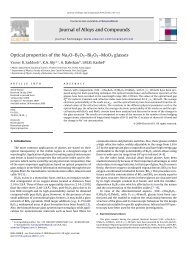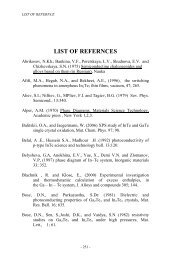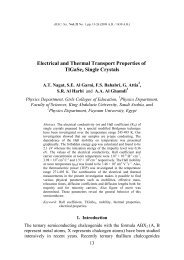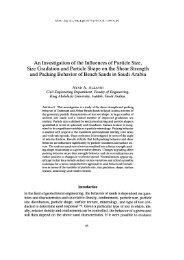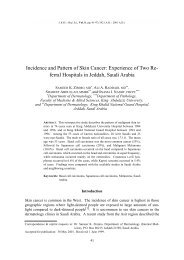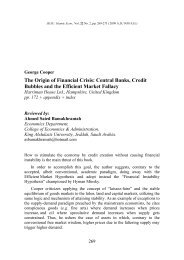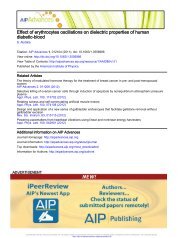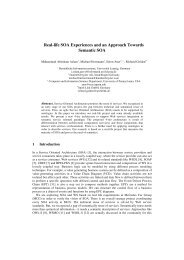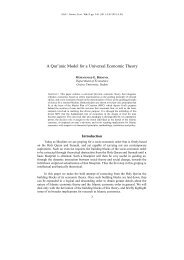De Vries equation with boundary conditions
De Vries equation with boundary conditions
De Vries equation with boundary conditions
You also want an ePaper? Increase the reach of your titles
YUMPU automatically turns print PDFs into web optimized ePapers that Google loves.
Adomian decomposition method for solving a Generalized<br />
Korteweg – <strong>De</strong> <strong>Vries</strong> <strong>equation</strong> <strong>with</strong> <strong>boundary</strong> <strong>conditions</strong><br />
Bothayna S. H. Kashkari<br />
<strong>De</strong>partment of Mathematics, Faculty of Science, King Abdulaziz<br />
University, Jeddah, Saudi Arabia<br />
Abstract . In this paper, the Adomian decomposition method for the<br />
approximate solution of generalized Korteweg de <strong>Vries</strong> <strong>equation</strong> <strong>with</strong><br />
<strong>boundary</strong> <strong>conditions</strong> is implemented. By using this method, the solution<br />
is calculated in the form of power series. The method does not need<br />
linearization, weak nonlinearity or perturbation theory. By using<br />
Mathematica Program, Adomian polynomials of the obtained series<br />
solution have been evaluated.<br />
Keywords: Adomian decomposition method; Korteweg–de<strong>Vries</strong><br />
<strong>equation</strong>.<br />
1. Introduction<br />
The concept of Solitary Wave was introduced to the budding science of<br />
Hydrodynamics in 1834 by Scott Russell. In the following decades after<br />
him the Solitary Wave of Translation was briefly mentioned by various<br />
mathematicians. During the latter half of the nineteenth century, a mild<br />
controversy arose centered on the statement. This was quoted from the<br />
basic paper written by Korteweg and de <strong>Vries</strong> in 1895. Based on the<br />
result of their work was the derivation of an <strong>equation</strong>, which cal later<br />
became known as the Korteweg – de <strong>Vries</strong> (KdV) <strong>equation</strong>. It describes<br />
1
the evolution of long water waves down a canal of rectangular cross<br />
section [1] , [2]. The non linear KdV <strong>equation</strong> has been the focus of<br />
considerable studies by [3-8] . A feature common to all these methods is<br />
that they are using the transformations to reduce the <strong>equation</strong> into more<br />
simple <strong>equation</strong> than solve it. The main difficulty in using such method<br />
is that the obtained integral <strong>equation</strong> cannot always be solved in terms of<br />
the simple function. Unlike classical techniques, the nonlinear problems<br />
are solved easily and elegantly, <strong>with</strong>out linearizing the problem by using<br />
the Adomian's decomposition method (ADM for short) [9-11].<br />
In this paper we are going to use the ADM to solve The<br />
Generalized Korteweg – <strong>De</strong> <strong>Vries</strong> <strong>equation</strong> (GKdV) :<br />
Where .<br />
Then we are going to use this method to solve the Modified Korteweg–<br />
<strong>De</strong> <strong>Vries</strong> <strong>equation</strong> (MKdV) :<br />
and Korteweg–<strong>De</strong> <strong>Vries</strong> Equation (KdV) :<br />
the generalized homogeneous KdV <strong>equation</strong>s <strong>with</strong> <strong>boundary</strong> <strong>conditions</strong><br />
will be handled more easily, quickly, and elegantly by the ADM rather<br />
than the traditional methods.<br />
2. Analysis of the Method<br />
In the preceding section we have discussed particular devices of the<br />
general type of the GKdV <strong>equation</strong>. For purposes of the ADM, in this<br />
study we shall consider the <strong>equation</strong> :<br />
(1)<br />
(2)<br />
(3)<br />
(4)<br />
2
Where<br />
The solution of which is to obtain subject to the <strong>boundary</strong> condition :<br />
(5)<br />
Where<br />
corresponds to the data from the exact solution.<br />
Let us consider the GKdV <strong>equation</strong> (4) in an operator form :<br />
(6)<br />
Where the notation<br />
notation<br />
symbolizes the nonlinear term , the<br />
symbolizes the linear differential operator.<br />
Assuming the inverse of the operator exists and it can conveniently<br />
be taken as the definite integral <strong>with</strong> respect to ; that is<br />
.<br />
Thus , applying the inverse operator to (2) yields :<br />
(7)<br />
thus<br />
(8)<br />
(9)<br />
we assign the zero component by :<br />
3
(10)<br />
A sum of components defined by the decomposition series :<br />
(11)<br />
and the nonlinear term<br />
Adomain's polynomials ; thus<br />
, we expressed in the form of<br />
(12)<br />
In this specific nonlinearity, we use the general form of formula for<br />
polynomials [3] :<br />
(13)<br />
This formula is easy to set computer code to get as many polynomial as<br />
well as explicit solutions , for the reader to follow easily , we can give<br />
the first few Adomian polynomials these are :<br />
(14)<br />
and so on , the other polynomials can be constructed in a similar way.<br />
4
The remaining components<br />
, can be completely<br />
determined so that each term is computed by using the previous term ,<br />
since is known ,<br />
……………………………….<br />
(15)<br />
As a result , the series solution is given by :<br />
3. Convergence Analysis of the Method<br />
(16)<br />
The convergence of the decomposition series has been investigated by<br />
several authors [12 - 13]. In this work we will discuss the convergence<br />
analysis [14] of ADM.<br />
Let us consider the Hilbert space, defined by :<br />
the set of applications :<br />
<strong>with</strong><br />
And the following scalar product :<br />
and :<br />
5
the associated norm.<br />
Let us write our problem in an operator form :<br />
and we set :<br />
Let us consider the hypotheses :<br />
<br />
whatever may be , there exists a constant<br />
such that for <strong>with</strong> we have :<br />
for every<br />
<strong>with</strong> the above hypotheses and , Cherruault [12] ; Mavoungou<br />
and Cherruault [13] have proved convergence of the method by using<br />
ideas developed by Cherruault [12] when applied to general partial<br />
differential <strong>equation</strong>.<br />
Now we can verify the convergence hypotheses<br />
constant such that for , we have :<br />
.<br />
; that is there exists<br />
6
Notice that<br />
constant<br />
are differential operators in , then there exist real<br />
such that<br />
Where .<br />
Similarly<br />
7
Sitting , we obtain hypothesis .<br />
We can prove the hypothesis , i.e. ,<br />
such that for <strong>with</strong> we have :<br />
Indeed we have :<br />
, .<br />
Where . Hence, the hypothesis is satisfied.<br />
4. Numerical Result<br />
Consider the GKdV <strong>equation</strong> :<br />
(17)<br />
8
for different values .<br />
It is well Known that this <strong>equation</strong> has the single soliton solution [15] :<br />
(18)<br />
where .<br />
When we put<br />
<strong>boundary</strong> condition:<br />
we get the KdV <strong>equation</strong>, consider the<br />
(19)<br />
Where<br />
corresponds to the data from the exact solution.<br />
By using ADM where and we get<br />
(20)<br />
and so on, then we have the approximation solution :<br />
(21)<br />
From Table 1 , we find that ADM has a small error. The and<br />
errors are contained in Table 2 . In Fig. 1 the surface shows the exact solution<br />
(a) and the approximation solution (b) of KdV <strong>equation</strong> (GKdV, ) for<br />
, and .<br />
9
Table 1 : Absolute error between the exact solution and approximation solution .<br />
0.2 0.4 0.6 0.8 1<br />
1 1.80521×10 -7 7.17809×10 -7 1.58906×10 -6 2.73578×10 -6 4.04845×10 -6<br />
2 4.12294×10 -8 1.63941×10 -7 3.62929×10 -7 6.24832×10 -7 9.24639×10 -7<br />
3 9.37623×10 -9 3.72828×10 -8 8.25358×10 -8 1.42097×10 -7 2.10278×10 -7<br />
4 2.13039×10 -9 8.4711×10 -9 1.87531×10 -8 3.22859×10 -8 4.7777×10 -8<br />
5 4.91693×10 -10 1.97594×10 -9 4.41198×10 -9 7.39243×10 -9 1.07838×10 -8<br />
Table 2 : and errors .<br />
t<br />
1 2.32152×10 -6 4.04845×10 -6<br />
2 5.3022×10 -7 9.24639×10 -7<br />
3 1.20581×10 -7 2.10278×10 -7<br />
4 2.73971×10 -8 4.7777×10 -8<br />
5 6.23778×10 -9 1.07838×10 -8<br />
(a) The surface of the exact solution<br />
(b) The surface of the approximation solution<br />
Fig. 1 : The surface shows the exact and the approximation solution of KdV <strong>equation</strong> for<br />
and .<br />
11
When we put we get the MKdV <strong>equation</strong> and by ADM<br />
where and we get<br />
(22)<br />
and so on, then we have :<br />
(23)<br />
From Table 3 , we find that ADM has a small error. The and<br />
errors are contained in Table 4 . In Fig. 2 the surface shows the exact solution<br />
(a) and the approximation solution (b) of MKdV <strong>equation</strong> (GKdV, ) for<br />
, and .<br />
Table 3 : Absolute error between the exact solution and approximation solution .<br />
0.2 0.4 0.6 0.8 1<br />
10 7.9373×10 -8 2.85056×10 -7 6.17804×10 -7 1.05734×10 -6 1.56517×10 -6<br />
20 3.04526×10 -12 1.21088×10 -11 2.68061×10 -11 4.61502×10 -11 6.82937×10 -11<br />
30 1.38253×10 -16 5.49737×10 -16 1.21699×10 -15 2.09521×10 -15 3.10052×10 -15<br />
40 6.27669×10 -21 2.4958×10 -20 5.52513×10 -20 9.51225×10 -20 1.40764×10 -19<br />
50 2.84961×10 -25 1.13309×10 -24 2.50841×10 -24 4.31855×10 -24 6.39065×10 -24<br />
11
Table 4 : and errors .<br />
t<br />
10 8.98557×10 -7 1.56517×10 -6<br />
20 3.9162×10 -11 6.82937×10 -11<br />
30 1.77795×10 -15 3.10052×10 -15<br />
40 8.07188×10 -20 1.40764×10 -19<br />
50 3.66463×10 -24 6.39065×10 -24<br />
(a) The surface of the exact solution<br />
(b) The surface of the approximation solution<br />
Fig. 2 : The surface shows the exact and the approximation solution of MKdV <strong>equation</strong> for<br />
and .<br />
5. Conclusions<br />
In this paper, the ADM has been successful in finding the solution of<br />
KdV and MKdV <strong>equation</strong>s <strong>with</strong> <strong>boundary</strong> <strong>conditions</strong>. A clear conclusion<br />
can be drawn from the numerical results that the ADM algorithm<br />
provides highly accurate numerical solutions <strong>with</strong>out spatial<br />
discretizations for the nonlinear partial differential <strong>equation</strong>s. In our<br />
work we use MATHEMATICA 7 for the direct evaluation of the<br />
Adomian polynomials of the obtained series solution.<br />
12
Finally, it is worthwhile to mention that the ADM can be applied<br />
to other nonlinear partia differential <strong>equation</strong>s in mathematical physics.<br />
Acknowledgements . The author would Like to thank the <strong>De</strong>anship of<br />
Scientific Research at King Abdulaziz University to support this<br />
research (no. 21-h006/429) and encourage researchers to continue the<br />
march of scientific research .<br />
6. References<br />
[1] Helal M.A., Mehanna M.S., A comparative study between two different methods for<br />
solving the general Korteweg–de <strong>Vries</strong> <strong>equation</strong> (GKdV), Chaos, Solitons and<br />
Fractals, 33 : 725–739 (2007).<br />
[2] Syam M.I., Adomian decomposition method for approximating the solution of the<br />
Korteweg–de<strong>Vries</strong> <strong>equation</strong>, Applied Mathematics and Computation, 162 : 1465–1473<br />
(2005).<br />
[3] Kutluay, S. , Bahadir, A.R. and Ozdes, A. , A small time solutions for the<br />
Korteweg-de <strong>Vries</strong> <strong>equation</strong>, Applied Mathematics and Computation, 107 (2) : 203-<br />
210, (Jan 2000).<br />
[4] Refik Bahadir, A. , Exponential finite-difference method applied to Korteweg-de<br />
<strong>Vries</strong> <strong>equation</strong> for small times, Applied Mathematics and Computation, 160 (3) : 675-<br />
682, (Jan 2005).<br />
[5] Ismail, M.S. , Numerical solution of complex modified Korteweg-de <strong>Vries</strong> <strong>equation</strong><br />
by Petrov-Galerkin method, Applied Mathematics and Computation, 202 (2) : 520-531,<br />
(Aug 2008).<br />
[6] Aksan, E.N. , Ozdes, A. , Numerical solution of Korteweg-de <strong>Vries</strong> <strong>equation</strong> by<br />
Galerkin B-spline finite element method, Applied Mathematics and Computation, 175<br />
(2) : 1256-1265, (Apr 2006).<br />
[7] Darvishi, M.T. , Kheybari, S. and Khani, F. , A numerical solution of the Kortewegde<br />
<strong>Vries</strong> <strong>equation</strong> by pseudospectral method using Darvishi's preconditionings, Applied<br />
Mathematics and Computation, 182 (1) : 98-105, (Nov 2006).<br />
[8] Helal, M.A. , A Chebyshev spectral method for solving Korteweg-de <strong>Vries</strong> <strong>equation</strong><br />
<strong>with</strong> hydrodynamical application, Chaos, Solitons and Fractals, 12 (5) : 943-950, (Jan<br />
2001).<br />
[9] Kaya, D. , An application for the higher order modified KdV <strong>equation</strong> by<br />
decomposition method, Communications in Nonlinear Science and Numerical<br />
Simulation, 10 (6) : 693-702, (Sep 2005).<br />
[10] Kaya, D., Inan, I.E. , A numerical application of the decomposition method for the<br />
combined KdV-MKdV <strong>equation</strong>, Applied Mathematics and Computation, 168 (2),<br />
p.915-926, Sep 2005.<br />
[11] Kaya, D., Inan, I.E., A convergence analysis of the ADM and an application, Applied<br />
Mathematics and Computation, 161 (3) : 1015-1025, (Feb 2005).<br />
[12] Cherruault Y., Convergence of Adomian's Method, Kybernetes, 18 (6) : 13 – 25,<br />
(1992).<br />
13
[13] Mavoungou T. , Cherruault Y. , : Convergence of Adomian's Method and<br />
Applications to Non-linear Partial Differential Equations, Kybernetes, 21 (6) : 13 – 25,<br />
(1992).<br />
[14] Ngarhasta N., Some B., Abbaoui K., Cherruault Y., New numerical study of<br />
Adomian method applied to a diffusion model, Kybernetes, 31 (1) : 61–75, (2002).<br />
[15] Ismail H. N. A., Kamal R. Raslan K. R., Salem G. S.E. , Solitary wave solutions for<br />
the general KDV <strong>equation</strong> by Adomian decomposition method, Applied Mathematics<br />
and Computation, 154 : 17–29, (2004).<br />
14
حل معادلة كورتويج ديفرز المعممة ذات الشروط الحدية باستخدام طريقة أدومين<br />
للتجزئة<br />
بثينة صالح قشقري<br />
قسم الرياضيات – كلية العلوم للبنات جامعة الملك عبد العزيز بجدة<br />
–<br />
.<br />
.<br />
المستخلص في هذا البحث طبقت طريقة أدومين للتجزئة لحل معادلة كورتويج ديفرز<br />
المعممة ذات الشروط الحدية وتقوم هذه الطريقة على تقديم الحل في صورة متسلسلة من<br />
كثيرات الحدود تتقارب إلى الحل المضبوط للمعادلة وتمتاز طريقة أدومين للتجزئة عن<br />
غيرها من الطرق العددية السابقة بأنها تعطي مباشرة نظاماً للحل يتضمن الحد غير الخطي<br />
مما يعطي دقة أكبر في النتائج وباستخدام برنامج الماثيماتيكا تم حساب كثيرات حدود أدومين<br />
في متسلسلة الحل<br />
.<br />
.<br />
.<br />
15




